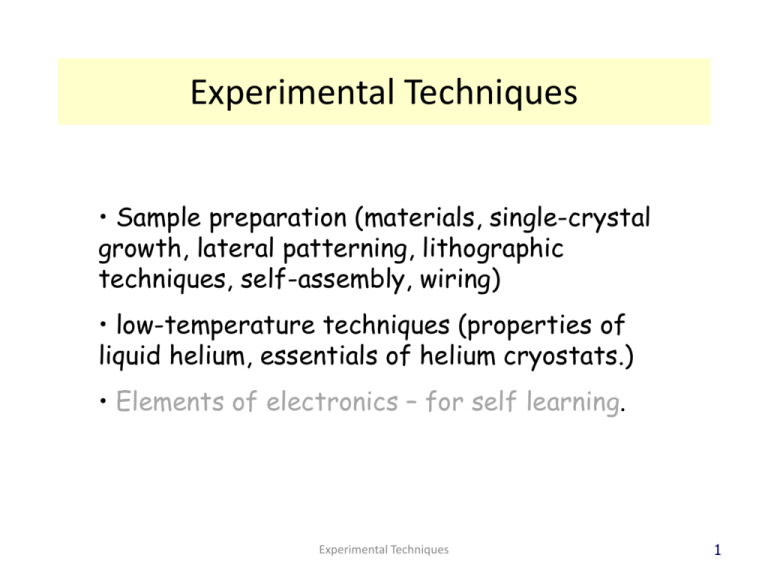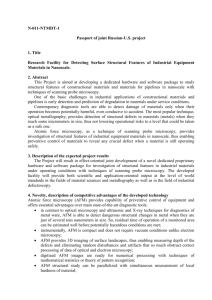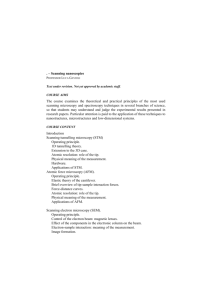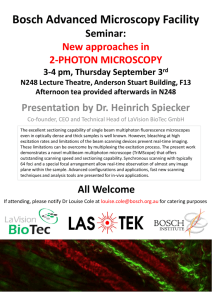Experimental techniques: sample preparation, elements of cryogenics
advertisement

Experimental Techniques • Sample preparation (materials, single-crystal growth, lateral patterning, lithographic techniques, self-assembly, wiring) • low-temperature techniques (properties of liquid helium, essentials of helium cryostats.) • Elements of electronics – for self learning. Experimental Techniques 1 Materials • Silicon dominates semiconducting industry, while GaAs is used where Si cannot be used (optoelectronics and ultra-highspeed, ultra-low-noise applications). Advantages of Si: the raw material (quartz sand) is widely available and cheap; mechanically stable in all process steps;SiO2 has excellent mechanical and electronic properties (high breakdown electric field and large resistivity). • GaAs is a binary material and as such more difficult to grow than Si. A general problem with multi-component melts is the different vapour pressures of the components. Vapour pressures must be controlled. As should have an overpressure of 0.9 bar. • In InP, the P overpressure should be 60 bar. Experimental Techniques 2 Si single-crystal growth and purification l d d v (a) The Czochralski technique for Si single crystal growth. The angular velocity and the longitudinal velocity are ω and v, respectively. (b) The zone pulling technique. v~ 1mm/s, d = 25 cm, l = 1 m. The crystal cylinder is cut into thin disks called wafers. A typical wafer thickness is 300 μm. http://en.wikipedia.org/wiki/Monocrystalline_silicon Experimental Techniques 3 Si single-crystal growth Si single crystal growth Czochralski process of crystal growth. Si has a melting point of 1412◦C at atmospheric pressure. Argon is usually used as inert atmosphere in the growth. After purification, the impurity concentrations below 1013 cm−3 can be obtained. Undoped Si crystals can have resistivities above 10 Ωm. If the crystal has to be doped, a doping gas atmosphere is established in the chamber, e.g. a B2H6 atmosphere for boron doping, or a PH3 atmosphere for phosphorus doping. Experimental Techniques Silicon crystal growth by Czochralski process at Raytheon, 1956. The induction heating coil is visible, and the end of the crystal is just emerging from the melt. http://en.wikipedia.org/wiki/Czochralski_process 4 GaAs single-crystal growth Compensating the overpressures: Liquid encapsulated Czochralski (LEC) technique: the melt is covered with a fluid that does not intermix with liquid melt. Bridgman technique: a closed tube contains a crucible that hosts the melt, a seed, the freshly grown crystal and a piece of solid As. The temperature of the solid As is kept at a value that corresponds to an As overpressure of 0.9 bar. http://cnx.org/contents/9f9b850b-7787-466e-9cef-d504dd10219e@1/Growth_of_Gallium_Arsenide_Cry Growth of layered structures Metal organic chemical vapour deposition (MOCVD) InP layered MOCVD growth The atoms of the semiconductor components to be grown are introduced via suitable molecular gas flows. The gas molecules crack at the surface and deposit the semiconductor atom on the substrate. http://en.wikipedia.org/wiki/Metalorganic_vapour_phase_epitaxy Experimental Techniques 6 Metal organic chemical vapor deposition (MOCVD) • For GaAs, a possible chemical reaction in MOCVD with Ga(CH3)3 and AsH3 as input gases is: Ga(CH3)3 + AsH3 → GaAs+3CH4 • The reaction takes place at temperature about 1120◦C. • The advantage of MOCVD is relatively low cost. • A disadvantage is the high toxicity of the gases involved. Experimental Techniques 7 Molecular beam epitaxy (MBE) In MBE atomic layers are grown in an ultra-high-vacuum chamber, with pressures of the order of 10−11 mbar. Experimental Techniques 8 Molecular beam epitaxy (MBE) • The components of the semiconductor are supplied by effusion cells. • The crystal can be grown monolayer by monolayer and can be selectively doped. The modulation doping can be easily implemented. • Typical growth rates are 0.1nm/s. • The quality of the samples is unsurpassed by any other method. • The growth can be calibrated and monitored with reflection high-energy electron diffraction (RHEED). Experimental Techniques 9 The Making of a Chip with 22nm/3D Transistors Metal organic chemical vapour deposition Crystal Growth by Molecular Beam Epitaxy Molecular Beam Epitaxy https://www.youtube.com/watch?v=d9SWNLZvA8g https://www.youtube.com/watch?v=1MFz0QToX6Q https://www.youtube.com/watch?v=NsGRKSV8yH8 https://www.youtube.com/watch?v=nvwNo-VY58Q AFM https://www.youtube.com/watch?v=MZb8C0f7Kdg AFM https://www.youtube.com/watch?v=Ha53tFTsmW8 STM atoms https://www.youtube.com/watch?v=WiFgwB_BADE Reflection high-energy electron diffraction (RHEED) An electron beam with an energy of about 10 keV hits the A RHEED system. Electrons follow the path surface under a very small angle. The reflected interference indicated by the arrow and approach the sample pattern is highly sensitive to the roughness. The reflected at angle θ. The sample surface diffracts intensity shows a minimum if the coverage of the monolayer electrons, and some of these diffracted electrons is 50%, which corresponds to maximum roughness. When a reach the detector and form the RHEED pattern. monolayer has just been completed, the scattering has the highest specularity. http://en.wikipedia.org/wiki/Reflection_high-energy_electron_diffraction Experimental Techniques 11 Cleaved edge overgrowth (CEO) (a) The layer growth by MBE is interrupted and the wafer is cleaved inside the chamber. Cleaving includes scratching the wafer at its edge and subsequently breaking it by mechanical pressure. The GaAs wafer breaks at the scratched position along a single crystal plane. (b) MBE growth is continued on top of this freshly cleaved surface. (c) The electrical connections to the different elements. Voltages can be applied to the two gates T and S, and a current is applied between the two areas separated by gate T. (d)–(f) Sketches of how different gate voltage combinations shape the electron gas. In particular, a one-dimensional wire is formed in (f), which extends along the quantum well at the cleaved and regrown interface. Experimental Techniques 12 MBE grown self-assembled quantum dots Growth of material B on top of material A in (a) the Volmer– Weber and (b) the Stranski–Krastanov modes. (c) Atomic force microscope picture of PbSe islands on a PbTe (111) substrate. Atomic force microscope is one of the scanning probe microscopes Experimental Techniques 13 Scanning probe microscopy AFM, atomic force microscopy [1] • Contact AFM • Non-contact AFM • Dynamic contact AFM • Tapping AFM •BEEM, ballistic electron emission microscopy[2] •CFM, chemical force microscopy •C-AFM, conductive atomic force microscopy[3] •ECSTM electrochemical scanning tunneling microscope[4] •EFM, electrostatic force microscopy[5] •FluidFM, fluidic force microscope[6][7][8][9] •FMM, force modulation microscopy[10] •FOSPM, feature-oriented scanning probe microscopy[11] •KPFM, kelvin probe force microscopy[12] •MFM, magnetic force microscopy[13] •MRFM, magnetic resonance force microscopy[14] •NSOM, near-field scanning optical microscopy (or SNOM, scanning near-field optical microscopy)[15] •PFM, Piezoresponse Force Microscopy[16] •PSTM, photon scanning tunneling microscopy[17] •PTMS, photothermal microspectroscopy/microscopy •SCM, scanning capacitance microscopy[18] •SECM, scanning electrochemical microscopy •SGM, scanning gate microscopy[19] •SHPM, scanning Hall probe microscopy[20] •SICM, scanning ion-conductance microscopy[21] •SPSM spin polarized scanning tunneling microscopy[22] •SSM, scanning SQUID microscopy •SSRM, scanning spreading resistance microscopy[23] •SThM, scanning thermal microscopy[24] •STM, scanning tunneling microscopy[25] •STP, scanning tunneling potentiometry[26] •SVM, scanning voltage microscopy[27] •SXSTM, synchrotron x-ray scanning tunneling microscopy[28] •SSET Scanning Single-Electron Transistor Microscopy [29] Experimental Techniques http://en.wikipedia.org/wiki/Scanning_probe_microscopy 14 Atomic force microscopy • The AFM consists of a cantilever with a sharp tip that is used to scan the specimen surface. • The cantilever is typically silicon or silicon nitride with a tip radius of curvature on the order of nanometres. • When the tip is brought into proximity of a sample surface, forces between the tip and the sample lead to a deflection of the cantilever according to Hooke's law.[4] • Hooke's law states that the force F needed to extend or compress a spring by some distance X is proportional to that distance. That is: F = -kX, where k is a constant factor characteristic of the spring, its stiffness. • Depending on the situation, forces that are measured in AFM include mechanical contact force, van der Waals forces, capillary forces, chemical bonding, electrostatic forces, magnetic forces (see magnetic force microscope, MFM), Casimir forces, solvation forces. http://virtual.itg.uiuc.edu/training/AFM_tutorial/ http://en.wikipedia.org/wiki/Scanning_probe_microscopy Experimental Techniques 15 MBE grown self-assembled quantum dots wetting layer EA, EB and EAB are surface energies per unit area related to the surfaces of material A and B and to interface between A and B. S is the fraction of the surface of A covered by B. The total energy is then: E = (1− S)EA + SEB + SEAB = EA+ S(EB + EAB - EA). If EB + EAB < EA, system will maximise S – layer growth If EB + EAB > EA, system will minimise S – island growth (a) For (b) the thickness d dependent stress energy Estrd needs to be introduced instead of EAB. Then initial layer growth takes place when EB + Estrd < EA or d < (EA- EB)/Estr . wetting layer Atomic force microscope Experimental Techniques 16 Stress induced self assembled quantum dots growth Wetting layer growth: d < (EA- EB)/Estr High stress promotes island growth. SAQDs have very homogeneous size distribution with variances around 10% only. Since their sizes are in the range of 20nm in width and a few nanometres in height. Strong quantization effects can be expected inside. Top: Transmission electron microscope picture of InAs layers, separated by 36 monolayers of GaAs. The vertical direction is the growth direction. The InAs SAQDs, seen as dark spots, align on top of each other. The bottom figure shows a schematic sketch of the SAQDs and the wetting layer. Experimental Techniques 17 Optical and electron beam lithography Column (a) is typical for Si fabrication steps. The substrate is covered with a homogeneous metal layer, which is subsequently coated with a suitable resist. Illumination and development of the resist through a mask exposes some areas of the metal layer, while others are protected by the resist. Since all suitable metal etchants attack GaAs, for it fabrication scheme (b) is typically used. For selective etching of the substrate, the patterned resist is used as an etch mask in (c). Lithography https://www.youtube.com/watch?v=1bxf9QRVesQ EB Lithography https://www.youtube.com/watch?v=25AsHRgBJDM Nano wonders https://www.youtube.com/watch?v=mEH6tDLKcVU Experimental Techniques 18 Optical lithography Top: Contact illumination. The mask pattern is transferred to the resist via illumination and subsequent development. Centre: Resulting resist cross section for positive (left) and negative (right) resist. Bottom: Solubility characteristics for the two resist types. • Photoresist (d ~ 1 μm) is illuminated by visible or ultraviolet light. • Illumination takes place through the mask. Smallest feature sizes are about half the wavelength (≈ 150 nm) divided by the index of refraction of the resist (≈ 1.5), which limits the resolution to roughly 100 nm. • In projection illumination the mask pattern is transferred to the resist via lenses. • Photoresists can be classified as positive and negative. The solubility of the exposed areas increases for a positive resist, while it decreases for a negative resist. Experimental Techniques 19 Photoresist and lithography • Solubility as a function of the illumination dosage is a step-like function. This ensures high resolution and sharp edge profiles. • A negative resist predominantly produces an undercut profile: after development the resist area in contact with the sample is smaller than the area at the resist surface. Good for lift-off! • X-ray lithography with wavelengths in the 10 nm range is possible. Obstacles: photoelectrons and transparency of metals. • Photoresist contains organic polymers. The crosslinking of the polymers is enhanced or reduced by the light, which modifies their solubility. The resolution cannot become better than the size of monomers, which is of the order of 0.5 nm. Experimental Techniques 20 Electron beam lithography • Used for feature sizes below ≈ 150 nm. • Instead of light, electrons are used for illuminating resists, which are polymers like PMMA (polymethylmethacrylate) with a well defined molecular weight. • In a positive resist, the electron beam breaks the bonds between the monomers, and an increased solubility results. In negative resists, the electron beam generates inter-chain crosslinking, which decreases the solubility. • Electrons have a very similar effect to ultraviolet light on the resist. • In contrast to optical lithography, this is a serial and therefore a slow process. However, structure sizes of 50 nm are possible. • A 30 keV electron beam produces spot sizes of about 1nm, but resolution is reduced by secondary electrons. • An undercut profile is intrinsic to this process. It can be enhanced by a two-layer electron beam resist. Experimental Techniques 21 Direct writing methods in lithography • Focused ion beam writing uses an ion source (e.g. gallium). The ions are implanted in the substrate and localize the electrons in the exposed areas. Highly resistive regions can be defined this way. However, the lateral depletion is rather large, typically above 100 nm. Suitable ion beams can also be used to dope the sample locally. • Scanning probe lithography is able to work with atomic resolution. Operations include moving single atoms, material deposition from the tip, scratching, local oxidation. • AFM tip acts as cathode. • The 2DEG is depleted underneath the oxide. Donor electrons are trapped in surface states instead of providing charge carriers to 2DEG. Experimental Techniques 22 Etching and metallization of semiconductors • Typical procedures are dry and wet chemical etching. Dry etching usually takes place in discharge gas. It is a plasma (frequently oxygen) or ion etching. • In reactive ion etching polymer is formed at the etched walls, which prevents lateral removal of material. Very steep and deep grooves can be etched. • In wet chemical etching majority of the common semiconductors are not attacked by pure acids. Typical etchant is a mixture of an oxidiser (such as H2O2), an acid (like HCl) and water. • In metallization a metal film grows on the exposed surfaces with a rate of a nanometre per second: monitored by an oscillating quartz plate. • Typical metallization layers have thickness between 20 nm and a few micrometres. • Important metallization technique is angle evaporation. Feature sizes below the lithographic resolution can be made by this technique. Experimental Techniques 23 Angle evaporation • A layer of electron beam soft resist Preparation of a small Al island coupled to two leads via smallarea tunnel barriers. (with low illumination dosage) is covered by a hard resist. This leads to cage formation as an extreme version of an undercut profile. The upper resist layer is free-standing over a certain area. • After angle evaporation a sandwich structure with small overlap areas results, which can be below the pattern sizes in the resist mask. • Resist here is used as a shadow mask. The overlap areas as small as 30 nm× 30 nm can be prepared routinely by angle evaporation. Experimental Techniques 24 Contacts to layered nanostructures • To obtain an Ohmic contact, a suitable metal is evaporated and alloyed into semiconductor. The metal should have a low melting point and act as a dopant. Schottky barrier should be small. • For GaAs, the Au0.88Ge0.12 is good choice. The Schottky barrier in this system is of 0.3 eV. Melting point of AuGe is 360◦C. At 420◦C it begins to alloy into GaAs. Ge atoms in Ga are donors. Diffusion of Ge into GaAs can be enhanced by adding a small fraction of Ni. The resistivity of contacts is of the order of 10−6 Ωm. Processing temperature is well below temperatures for Si dopant migration in GaAs. • Position of contacts is important in high field applications since electron gas localizes around the contacts (a) and strongly increases their resistance. Placing them over edge is a solution (b). Experimental Techniques 25 Wire bonding • Main techniques of attaching wires to the Ohmic contacts and gate electrodes are ball bonding and wedge bonding. • In ball bonding the gold wire is molten and pressed by ball against a bond pad. • In wedge bonding, wire is pressed against the bond pad and rubbed across it with an ultrasonic frequency. The friction is sufficient to locally melt the materials, and an alloy is formed that holds the wire in place (b), (c). • After the typically second bond, the wire is pulled and broken at the weakest point (d). Experimental Techniques 26 Elements of cryogenics: properties of liquid helium • Helium is the only element that remains liquid when cooled to the temperatures well below 1 mK. The latent heat that has to be absorbed when liquid helium is evaporated generates the cooling power. • Helium comes in two isotopes, the boson 4He and the fermion 3He. • Helium is the only element for which the van der Waals force is smaller than the kinetic energy of the atoms due to zero-point fluctuations. 4He ρ(L4He) = 125 kg/m3 4He Superfluid fraction xsf of He II as a function of temperature. reaches 1mbar at Θ = 1.2K Phase diagram of 4He. Superfluid helium: https://www.youtube.com/watch?v=2Z6UJbwxBZI https://www.youtube.com/watch?v=bmvlIdNXxjM https://www.youtube.com/watch?annotation_id=annotation_187285&feature=iv&src_vid=1RJKnbIvbMg&v=OIcFSHAz4E8 Experimental Techniques 27 Properties of superfluid helium • The superfluid helium has zero entropy and zero viscosity, which means, for example, that there is no flow resistivity. The thermal conductivity of the superfluid is in theory infinitely large. • In He II, the thermal conductivity is very large, and evaporation takes place at the surface only. Hence, He II is perfectly quiet, even if it boils off. • Phase transition to superfluid helium is a Bose–Einstein condensation process. • Superfluid helium displays phenomenon of superleak. • Superfluid He tends to creep over any wall and shows extreme adhesion to surfaces and “complete wetting” effect. (a) Sketch of a He II osmotic cell. (b) Superfluid film creeping across a wall. https://www.youtube.com/watch?annotation_id=annotation_187285&feature=iv&src_vid=1RJKnbIvbMg&v=OIcFSHAz4E8 Experimental Techniques 28 Properties of pure 3He • The density of L3He is ρ(3He) = 59 kg/m3. Under atmospheric pressure, it liquefies at Θ = 3.19 K. It is near-to-completely absent on Earth. • The vapour pressure is higher (at identical temperatures) than in L4He. Pressure drops to 10−3mbar at about Θ = 270mK. • 3He atoms are fermions, and the liquid can be approximated by a Fermi gas. • For Θ < 2mK, the 3He atoms form Cooper pairs and undergo a Bose–Einstein condensation into superfluid 3He. Seamounts release plumes of 3He-rich water into the ocean. These helium plumes can be traced for thousands of kilometres Phase diagram of 3He. Experimental Techniques http://www.threesology.org/3sxamples13.php 29 The 3He/4He mixture • For temperatures below 860 mK, an important phase separation into a dilute 3He-poor phase (D) and a 3He-rich phase (C) takes place. • The 3He dissolved in 4He is a dilute Fermi gas with an effective mass ≈ 2.4m(3He). 3He atoms move in 4He without friction. • The chemical potential of the C-phase is somewhat higher than that, of a single 3He atom in 4He. Hence, 3He atoms will go into 4He until the chemical potentials have aligned. Phase separation is important for operation of dilution refrigerators. Phase diagram of the 3He/4He mixture vs. 3He concentration x and temperature Θ and a sketch of the chemical potential shift of the two phases at Θ = 0. Experimental Techniques 30 4He cryostats • In a cryostat, He is isolated from the environment by a vacuum jacket. LHe container is made of a material with a poor thermal conductivity, such as glass or stainless steel. • Main types of 4He cryostats are bath cryostat and gas flow cryostat. • In a bath cryostat temperature is reduced by pumping. • He vapour pressure p drops exponentially as temperature Θ decreases: p(Θ) = p0 exp (− L/kBΘ). • Low pressure and high pumping speed is necessary to reach low temperatures. Θ ~ 1.2K at p=1mbar. • Continuous variation of temperature between 1.2K and room temperature Sketches of a 4He bath cryostat (left) and a 4He gas flow cryostat (right). is possible in a gas flow cryostat. Experimental Techniques 31 3He cryostats • Below 1K, the vapour pressure of 3He is much higher than that of 4He. Temperatures down to about 270mK can be reached by pumping L3He. • 4He is used for a precooling stage. • 3He is kept in a closed cycle. • Evaporated 3He gas can be condensed by a small, pumped 4He pot, which is connected to the 4He bath via a needle valve, such that its temperature stays well below 3.2K. • Some cryostats are equipped with a continuous flow option, where, the pumped 3He is immediately re-condensed. • With somewhat higher base temperature, measurement period becomes unlimited. Experimental Techniques 32 3He/4He dilution refrigerator • Since the dilute 3He phase (D) can be thought of as the 3He vapour of the 3He-rich phase (C) with a significant vapour pressure even at T=0, pumping the 3He atoms out of the D is able to reduce T down to 1 mK. • C phase has a smaller density than D and the “liquid” is floating on top of the “gas”. • Pumping the 3He atoms out of the D phase pulls the corresponding effective latent heat out of the mixture. • The D phase is connected through a tube with the still heated to about 600 mK. At this temperature, the vapour pressure of 3He is significant, while that of 4He is negligible. The still therefore effectively distils 3He from the D phase. • 3He is re-condensed in the “1K pot”. Essential components of a 3He/4He dilution refrigerator. Experimental Techniques 33 Home activity for Thu. 18 February a) Read: TH, Chapter 4 ‘Experimental Techniques’ (pp 116-156). Try to understand the importance of experimental techniques for investigation of nano-scale effects. Identify issues that you would like to discuss on Practical, Thu. 18 February. b) Work with questions to Chapter 4: Questions and other questions. c) Go again through Chapters 1 and 2 in TH focusing on Hall effect, pp 2426, the electronic density of states, pp. 66-68, and the magnetoresistivity tensor on pp. 65-66 (for Mon. 22 February). d) Read chapter ‘Application and detection of electronic signals’ if it is close to your activity: TH, pp. 147-154. Can you explain main points of this chapter to other students on practical? e) Address exercises in TH P4.1 – P4.4 on p. 154 and E4.1 – E4.3 on pp. 154-155. Try to answer Questions 4.1 - 4.2 on page 143. Can you explain solutions to other students and teacher on practical? Einstein relation (kinetic theory) http://en.wikipedia.org/wiki/Einstein_relation_(kinetic_theory) Equipartition theorem http://en.wikipedia.org/wiki/Equipartition_theorem








